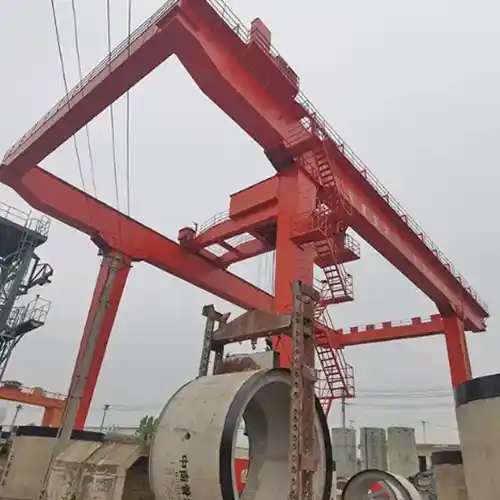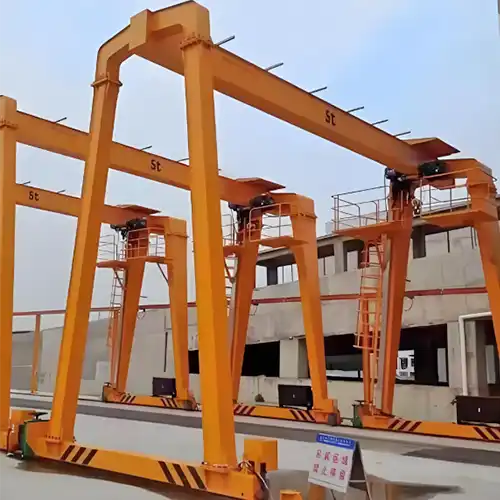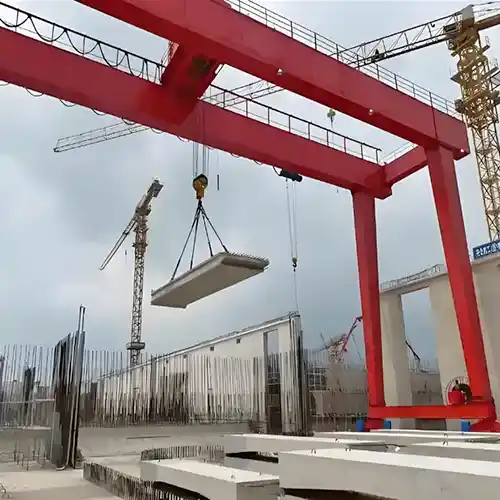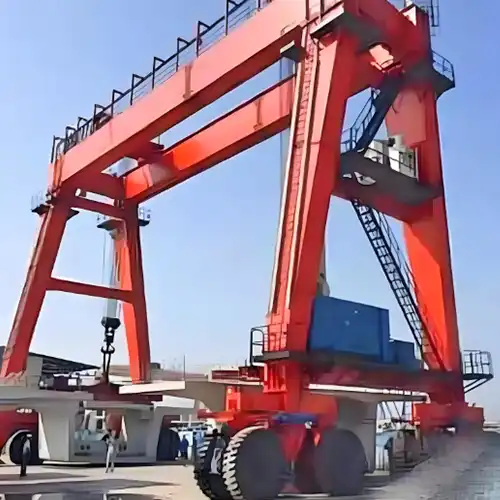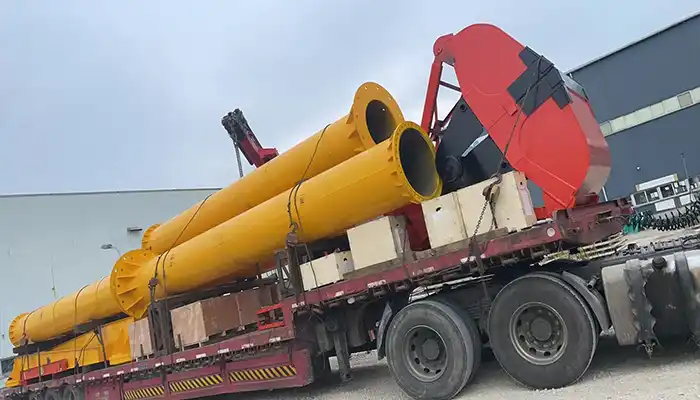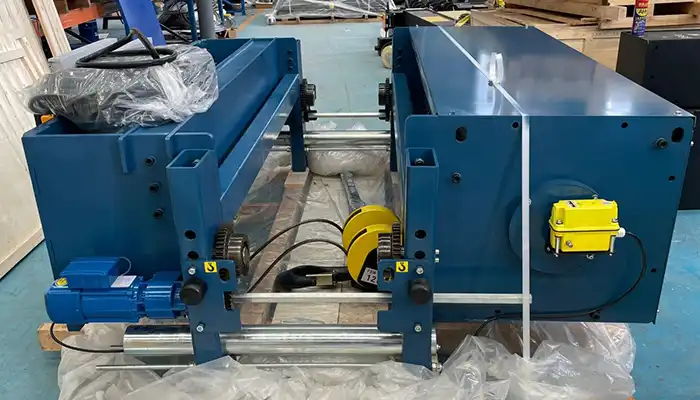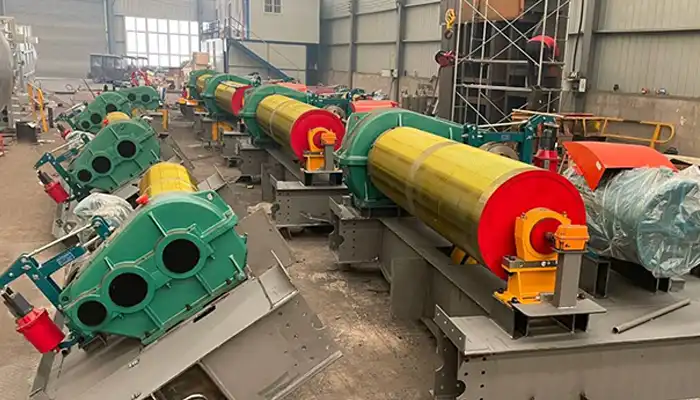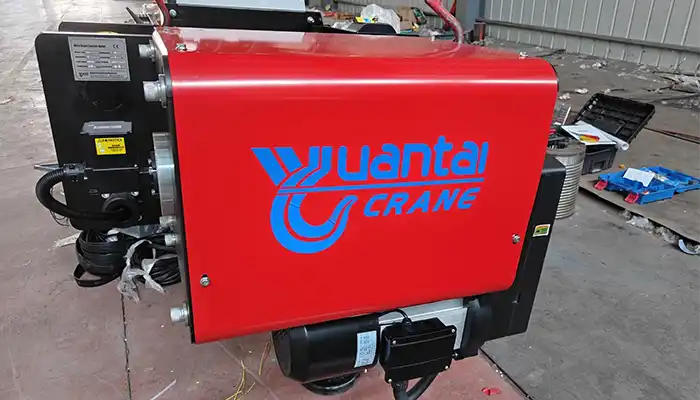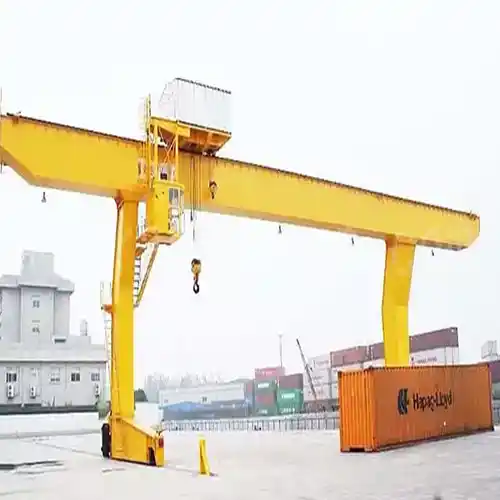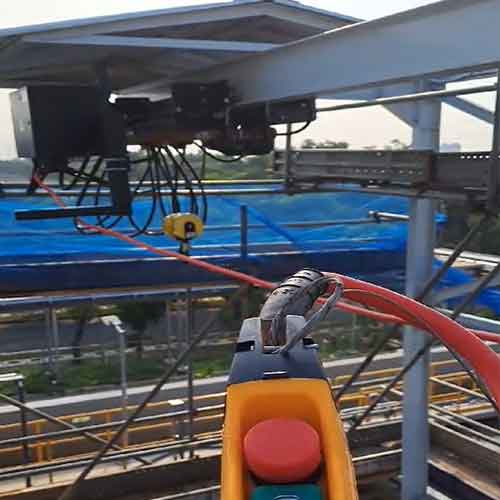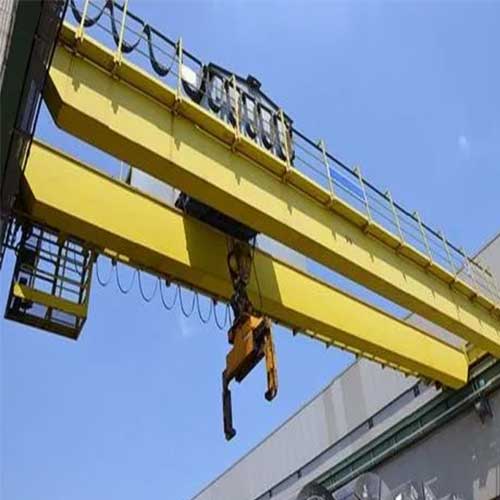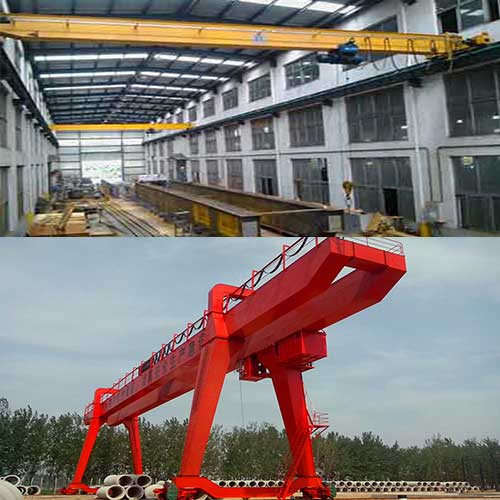Wireless Control for Outdoor Gantry Cranes: Boosting Efficiency
Explore how wireless control systems enhance safety, efficiency, and adaptability while managing environmental risks in outdoor gantry crane operations.
Category: Featured
Your Trusted Outdoor Crane Manufacturer & Supplier
Wireless Control for Outdoor Gantry Cranes
Managing Environmental Risks and Boosting Efficiency
Outdoor Gantry Cranes: What They Are and Where They're Used
Outdoor gantry cranes are large, powerful lifting machines designed for outdoor use. They’re typically used in places where other cranes can’t operate efficiently, like ports, construction sites, shipyards, and industrial yards. These cranes move along rails or tracks, making them ideal for lifting heavy loads over large, open spaces.
Typical Applications:
- Construction: Lifting heavy materials like beams and concrete slabs, often in challenging outdoor conditions.
- Shipping and Ports: Loading and unloading shipping containers, making them essential for efficient port operations.
- Heavy Lifting: Moving large machinery or materials in industrial environments, like steel plants or large construction projects.
Outdoor gantry cranes are important because they allow businesses to handle large and heavy materials safely and efficiently, even in tough outdoor conditions.
Why Wireless Control Systems Matter for Outdoor Gantry Cranes
Wireless control systems are changing how outdoor gantry cranes are operated. In the past, operators had to control cranes from a cabin or with wired controls, often putting them close to the crane and its heavy load. With wireless control, operators can control the crane remotely from a safe distance.
How Wireless Control Improves Crane Operations:
- Increased Safety: Operators can stay away from dangerous areas and still control the crane.
- More Flexibility: Wireless systems allow operators to control the crane from various locations, improving visibility and reducing risks in tight or busy spaces.
- Real-Time Monitoring: Wireless controls often include monitoring features, allowing operators to track the crane’s performance, load weight, and other important data to prevent issues before they arise.
The Importance of Modern Technology for Outdoor Environments
Outdoor conditions can be unpredictable, with weather, dust, and even extreme temperatures affecting crane operations. That’s where modern technology comes in. Wireless control systems are designed to work reliably, even in tough conditions.
Key Benefits of Technology in Outdoor Environments:
- Weather Resistance: Wireless systems are built to withstand harsh weather conditions, ensuring the crane keeps working smoothly.
- Advanced Features: Many wireless systems include GPS tracking, sensors, and load monitoring to provide real-time insights into crane performance, helping operators make smarter decisions.
- Safety and Efficiency: By integrating wireless technology with other smart systems, cranes can operate more safely and efficiently, reducing downtime and the risk of accidents.
In industries like construction, shipping, and heavy lifting, where outdoor conditions can change quickly, modern wireless control systems help ensure that cranes perform reliably and safely, no matter what.
This revised version simplifies the content, breaking it down into clear, easy-to-understand sections. Each part is concise and focuses on key points, making it easier for readers to grasp the importance of outdoor gantry cranes and wireless control systems in various industrial environments.
Environmental Challenges in Outdoor Crane Operations
Weather Conditions: Impact of Rain, Snow, and Extreme Temperatures
Outdoor gantry cranes face significant challenges when it comes to weather. Heavy rain, snow, and extreme temperatures can all affect crane operations in different ways:
Rain and Snow: Wet or icy conditions can make crane tracks slippery, reducing the crane's stability and making it harder to maneuver safely. In addition, snow and rain can interfere with electronic controls and sensors, potentially leading to malfunction or operational delays.
Extreme Temperatures: Extremely high or low temperatures can affect the performance of crane components. Cold weather can cause metal parts to become brittle, while hot weather can lead to overheating of the crane’s electrical and hydraulic systems. Both can result in breakdowns or reduced lifting capacity.
To maintain crane performance in all weather conditions, advanced weather-resistant designs, and protective coatings are essential. Wireless control systems also help mitigate risks by allowing operators to adjust operations based on real-time environmental data.
Dust, Debris, and Corrosion Risks: How Environmental Factors Affect Crane Durability and Safety
Outdoor environments, especially those near construction sites, industrial areas, or ports, often expose cranes to dust, debris, and harsh environmental conditions that can wear down equipment over time.
Dust and Debris: Construction sites and warehouses can produce large amounts of dust and debris that can get into the crane's mechanical parts. Over time, this can lead to blocked moving parts, causing wear and tear, or even complete failure if not properly maintained.
Corrosion: Exposure to salty air, chemicals, and moisture can cause rust and corrosion, especially in coastal or humid environments. Corroded parts can compromise the structural integrity of the crane, leading to breakdowns or safety hazards.
To combat these risks, cranes need to be built with corrosion-resistant materials and regular maintenance routines that clean and protect sensitive parts. Anti-corrosion coatings and regular inspections can significantly extend the life of the crane and ensure safe operation.
Space Constraints and Site Layout: How Limited Space or Irregular Terrain Complicates Crane Operations
Another major challenge in outdoor crane operations is the limited space or uneven terrain of the working area. Cranes need enough space to move freely and lift heavy loads without obstruction, but tight or irregular spaces can make it difficult to maneuver.
Limited Space: In busy areas like ports or construction sites, space can be cramped. Cranes may need to lift and move materials in narrow aisles, between buildings, or around other machinery. This makes it harder to operate efficiently and increases the risk of accidents if the crane isn’t handled carefully.
Irregular Terrain: Outdoor sites often feature uneven ground, slopes, or obstacles that can make it difficult for cranes to operate. If the crane isn't set up properly on unstable or uneven terrain, it can affect its lifting capacity, stability, and safety.
Modern outdoor gantry cranes are designed to operate in these challenging conditions, with flexible control systems, stabilizing features, and the ability to adjust for uneven ground. Wireless control also plays a role in improving maneuverability, allowing operators to make adjustments in real-time and better navigate tight spaces.
This section covers the key environmental challenges outdoor gantry cranes face, including weather conditions, debris and corrosion risks, and space limitations. By addressing these challenges head-on, crane operations can be better planned and optimized for safety and efficiency.
Benefits of Wireless Control for Outdoor Gantry Cranes
Enhanced Safety: Remote Operation Reduces Operator Risk
Wireless control systems help improve safety in outdoor crane operations by allowing operators to control the crane from a safe distance. Traditionally, crane operators worked in cabins located close to the crane and the heavy load, putting them at risk in hazardous environments.
- Reduced Proximity to Hazards: Operators are no longer required to be near the crane’s lifting path, minimizing exposure to dangerous elements.
- Better Visibility: With remote operation, operators can position themselves in safer, more visible areas, improving decision-making and reaction times.
By keeping operators away from risky environments like construction sites and shipyards, wireless control systems make crane operations safer for all involved.
Increased Efficiency: Real-Time Monitoring and Streamlined Operations
Wireless control systems increase crane efficiency through better monitoring and faster response times. Operators can access real-time performance data, which helps in making timely adjustments to improve crane operation.
- Real-Time Data Monitoring: Operators can monitor load weight, crane speed, and mechanical status continuously.
- Fewer Personnel: Wireless control reduces the need for multiple personnel on-site, simplifying operations and minimizing human error.
This combination of monitoring and fewer personnel helps to speed up processes, reduce delays, and ensure that crane operations are efficient and effective.
Operational Flexibility: Mobile and Remote Control Adaptation
Wireless control offers significant flexibility in how outdoor gantry cranes are operated, allowing operators to control cranes from a variety of locations.
- Control from Mobile Devices: Operators can control cranes from their mobile devices, providing more freedom and better positioning.
- Adaptation to Site Conditions: Wireless control allows for easier adjustment to different environments, such as narrow spaces or uneven terrain.
This flexibility enables the crane to be used more efficiently in different outdoor environments, with minimal setup changes needed.
Wireless control for outdoor gantry cranes offers clear benefits: enhanced safety by keeping operators at a distance from hazards, increased efficiency through real-time data and fewer personnel, and improved flexibility by allowing operators to control cranes from various locations. These advantages contribute to safer, more efficient, and adaptable crane operations in outdoor environments.
Managing Environmental Risks with Wireless Control
Adaptation to Harsh Weather Conditions: Performance in Extreme Weather
Wireless control systems are designed to operate reliably in extreme weather conditions, ensuring cranes perform well in all environmental circumstances.
- Weather Resistance: Wireless systems are built to withstand harsh conditions, such as heavy rain, snow, and high winds, ensuring that communication remains stable.
- Maintained Communication Integrity: Even in challenging weather, wireless signals maintain integrity, allowing operators to control the crane safely and efficiently from a distance.
These features make wireless control systems a dependable choice for cranes operating in outdoor environments, where weather can pose significant challenges.
Minimizing Wear and Tear: Remote Diagnostics and Proactive Maintenance
Environmental exposure can lead to wear and tear on outdoor cranes, but wireless control systems help mitigate this risk through advanced diagnostic capabilities.
- Remote Diagnostics: Wireless systems can detect issues in real-time, allowing for quick identification of potential problems, even before they affect crane performance.
- Proactive Maintenance Scheduling: By monitoring the crane’s performance continuously, maintenance teams can schedule repairs or adjustments before wear and tear cause significant damage, extending the life of the crane.
This proactive approach minimizes downtime and ensures the crane remains in optimal working condition, even in harsh outdoor conditions.
Enhanced Control in Challenging Terrain: Improved Maneuverability and Accuracy
Wireless control provides greater accuracy and maneuverability when working in challenging terrain or tight spaces, making it ideal for environments that require precision.
- Improved Accuracy: Operators can control the crane more precisely from a remote location, allowing them to navigate difficult terrain or confined spaces with greater ease.
- Better Maneuverability: Wireless systems allow operators to adjust crane movements in real time, improving responsiveness in complex or crowded environments.
This enhanced control ensures cranes can operate efficiently in environments where traditional methods might struggle, such as in narrow or irregularly shaped outdoor work sites.
Wireless control systems help manage environmental risks by ensuring cranes can adapt to extreme weather, reduce wear and tear through proactive maintenance, and improve maneuverability in challenging terrain. These benefits make wireless control an essential feature for outdoor gantry cranes working in diverse and often difficult environments.
Boosting Efficiency through Wireless Systems
Improved Coordination: Better Communication Among Teams
Wireless systems greatly enhance coordination between crane operators, maintenance crews, and other team members working on-site. These systems ensure clear communication, which is vital for efficient operations.
- Synchronized Operations: Wireless communication allows team members to stay in constant contact, ensuring that tasks are performed in sync, reducing delays and minimizing the risk of mistakes.
- Real-Time Updates: Operators and team members can share real-time information, making it easier to adjust the operation based on immediate needs or changing conditions.
This level of coordination speeds up workflow, improves safety, and enhances overall operational efficiency in environments where multiple teams need to work together seamlessly.
Data-Driven Decision Making: Integration of Data Analytics
Wireless control systems integrate data analytics, which helps optimize crane performance and reduce operational costs.
- Performance Monitoring: The system continuously collects data on crane functions such as lifting capacity, speed, and mechanical health.
- Minimizing Downtime: By analyzing performance trends, operators and maintenance teams can predict and prevent failures before they occur, reducing costly downtime.
- Cost Reduction: Data-driven insights help identify inefficiencies in crane operations, leading to better resource allocation and reduced operational costs.
Through data analytics, wireless control systems empower decision-makers to optimize crane usage, leading to improved performance and significant cost savings.
Remote Troubleshooting: Diagnosing and Resolving Issues Without On-Site Intervention
One of the key benefits of wireless control is the ability to troubleshoot and resolve issues remotely, minimizing the need for on-site intervention.
- Remote Diagnostics: Operators and maintenance teams can diagnose issues from a distance by accessing system data and performance metrics in real time.
- Quick Resolution: Remote troubleshooting allows issues to be identified and fixed quickly, often without requiring technicians to visit the site, saving both time and resources.
This capability reduces downtime, speeds up repairs, and allows for smoother operations, especially in remote locations where on-site intervention can be time-consuming and costly.
Wireless control systems boost efficiency in outdoor gantry crane operations by improving coordination, enabling data-driven decision-making, and allowing remote troubleshooting. These benefits streamline operations, reduce costs, and ensure cranes operate at peak efficiency, making them an invaluable asset in modern industrial environments.
Technological Features Supporting Wireless Control Systems
Real-Time Monitoring and Feedback: Continuous Performance and Environmental Tracking
Wireless control systems offer real-time monitoring, providing operators with instant access to critical performance data and environmental conditions.
- Continuous Performance Monitoring: Operators can track key parameters such as load weight, lifting speed, and mechanical health throughout the operation. This data helps ensure the crane is functioning optimally and allows for immediate adjustments if necessary.
- Environmental Factor Tracking: Wireless systems also monitor environmental conditions, such as weather, wind speed, and temperature, which may impact crane operation. Operators can adjust operations accordingly to maintain safety and performance under varying conditions.
These continuous feedback loops allow operators to make informed decisions and avoid issues that could affect crane performance, leading to safer and more efficient operations.
User-Friendly Interfaces: Simplified Control for Operators
Wireless control systems are equipped with user-friendly interfaces designed for ease of use, ensuring that crane operators can efficiently manage the crane’s operation.
- Intuitive Control Panels: The systems often feature easy-to-read digital displays that show important data in a straightforward, accessible format. This helps operators make quick, informed decisions during operation.
- Mobile Apps for Remote Control: Many wireless systems allow crane operators to control cranes via mobile apps, which offer simple, touch-screen interfaces for quick adjustments and real-time monitoring, even from a remote location.
These user-friendly systems reduce the learning curve for operators and allow them to efficiently manage crane functions, even in complex or high-pressure environments.
Security Protocols: Ensuring Safe and Interference-Free Communication
Security is a key component of wireless control systems to protect both the crane’s operation and the integrity of the data being transmitted.
- Encrypted Communication: Wireless control systems use encrypted signals to prevent unauthorized access, ensuring that only authorized personnel can control the crane.
- Interference-Free Operations: The systems are designed to minimize interference from external sources, such as other wireless devices or environmental factors, to ensure consistent and reliable communication.
These security protocols safeguard crane operations, reduce the risk of cyber threats, and ensure that the control system remains reliable and secure at all times.
Wireless control systems are equipped with essential technological features such as real-time monitoring, user-friendly interfaces, and robust security protocols. These features enhance crane operation by providing operators with vital information, simplifying controls, and ensuring secure, uninterrupted communication. Together, they contribute to a safer, more efficient, and reliable crane operation.
Case Studies and Applications
Example 1: Outdoor Gantry Cranes in Ports
Wireless control systems have significantly enhanced crane operations in port environments, where efficiency and safety are critical.
- Improved Efficiency and Safety: In busy ports, cranes are often used to load and unload large containers from ships. Wireless control systems allow operators to control cranes remotely, reducing the need for manual intervention and improving the speed of operations.
- Adaptability to Weather Conditions: Wireless systems help maintain crane performance even in harsh conditions like high winds or heavy rainfall. Operators can adjust crane movements in real time without being exposed to environmental risks.
- Streamlined Communication: Ports often have complex operations with multiple cranes in action simultaneously. Wireless control systems improve coordination between operators and other teams, ensuring synchronized movements and reducing the risk of accidents or delays.
This case shows how wireless systems enhance crane operations in a port setting by offering better safety, faster operation, and more effective communication.
Example 2: Construction Sites with Harsh Weather Conditions
Construction sites often face unpredictable weather, from high winds to extreme temperatures, which can disrupt crane operations. Wireless control systems have proven effective in these challenging conditions.
- Adaptation to Extreme Weather: Construction cranes are critical for lifting heavy materials. Wireless systems allow operators to control cranes from a safe distance, reducing exposure to dangerous weather while still making precise adjustments.
- Remote Monitoring and Adjustment: On construction sites with rapidly changing conditions, wireless systems enable real-time monitoring of both crane performance and weather factors, allowing operators to make adjustments as needed to prevent accidents and delays.
- Reduced Downtime: Wireless systems allow operators to diagnose issues remotely and initiate repairs without needing to stop operations or send personnel into unsafe conditions, minimizing downtime and keeping projects on track.
In construction environments, wireless control systems ensure that cranes can continue to operate efficiently and safely, even under unpredictable weather conditions, improving overall site productivity.
These case studies illustrate the practical benefits of wireless control systems in diverse outdoor environments, from busy ports to construction sites facing extreme weather. The systems enhance safety, improve operational efficiency, and allow for real-time adjustments, making them a valuable tool in modern crane operations.
Conclusion
Wireless control systems provide significant advantages in outdoor crane operations. Key benefits include:
- Enhanced Safety: Remote control minimizes the risk to crane operators by keeping them at a safe distance from hazardous environments.
- Increased Efficiency: Real-time monitoring and data analytics streamline crane operations, improving performance and reducing downtime.
- Improved Adaptability: Wireless systems allow cranes to function effectively in challenging environments, whether it’s harsh weather, limited space, or complex terrain.
These features make wireless control an indispensable tool for improving both the safety and operational efficiency of outdoor gantry cranes.
For businesses looking to enhance the efficiency and safety of their outdoor crane operations, upgrading to wireless control systems is a step toward the future. By implementing these systems, companies can:
- Improve operational efficiency by streamlining communication and reducing downtime.
- Increase safety by keeping operators out of harm’s way in unpredictable environments.
- Adapt easily to changing conditions, whether they involve weather, terrain, or worksite limitations.
Don’t wait for environmental risks or operational inefficiencies to impact your business—invest in wireless control systems today and elevate your crane operations to the next level.
Main Projects
Related Products
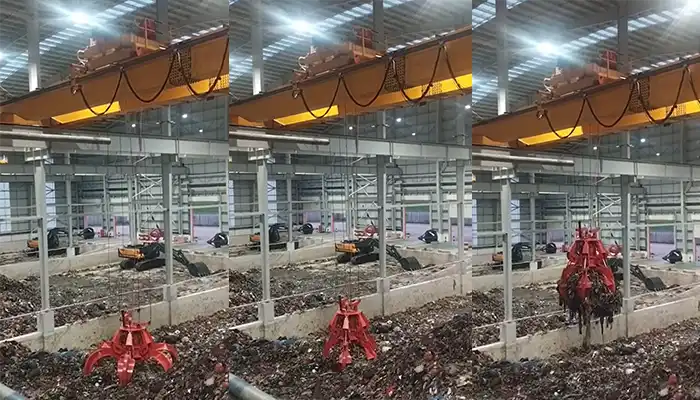
Supplied three grab bucket crane kits to Indonesia, enhancing garbage handling efficiency with high load capacity and reliable performance.
Free consultation to Confirm Parameters & Specifications and Get
Latest Crane Price & Crane Rate.
- Types of overhead cranes : _______?
- Optional: Overhead travelling crane, goliath gantry crane,Slewing jib crane, Single girder or double girder crane,small portable crane or kbk crane, etc.
- Capacity of overhead crane: _______?
- Optional: 0.25ton, 0.5 ton, 1 ton, 2 ton, 3ton, 5 ton, 10 ton,15ton, 20ton, 25 ton, 30ton,35ton, up to 550ton, etc.
- Crane span & lifting height : _______?
- Crane travelling length : _____?
- Control of overhead crane:_______?
- Optional: pendant/ remote/cabin control
- Voltage supply of overhead crane:_____?
- Eg,: 380V50/60HZ,3Phase or others,etc.
- Application/usage of crane:_______?
- Eg,: Steel mill, ,injection mold, cement,stone, concrete,granite, general manufacturing, etc.
Just leave a message via the contact form and our hoist and crane engineer will contact you with in 24working hours.
Get In Touch
